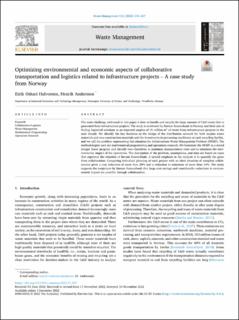| dc.contributor.author | Halvorsen, Eirik Oskari | |
| dc.contributor.author | Andersson, Henrik | |
| dc.date.accessioned | 2023-01-05T08:37:15Z | |
| dc.date.available | 2023-01-05T08:37:15Z | |
| dc.date.created | 2022-12-02T10:00:29Z | |
| dc.date.issued | 2022 | |
| dc.identifier.citation | Waste Management. 2023, 156 159-167. | en_US |
| dc.identifier.issn | 0956-053X | |
| dc.identifier.uri | https://hdl.handle.net/11250/3041101 | |
| dc.description.abstract | The main challenge addressed in this paper is how to handle and recycle the large amount of C&D waste that is generated from infrastructure projects. The study is motivated by Bærum Ressursbank in Norway and their aim of finding logistical solutions to an expected surplus of 15 million of waste from infrastructure projects in the next decade. We identify the key decisions as the design of the distribution network for both surplus waste materials and new construction materials and the investments in processing machinery at each recycling facility, and we call the problem representing this situation the Infrastructure Waste Management Problem (IWMP). The methodologies used are mathematical programming and operations research. We formulate the IWMP as a mixed integer linear program and identify two objectives; to minimize transportation costs and to minimize the environmental impact of the operations. The description of the problem, assumptions, and data are based on cases that represent the situation of Bærum Ressursbank. A special emphasis in the analysis is to quantify the gains from collaboration. Comparing individual planning of each project with an ideal situation of complete collaboration gives a cost reduction of more than and a reduction in emissions of more than . The study supports the conjecture by Bærum Ressursbank that large cost savings and considerable reductions in environmental impact are possible through collaboration. | en_US |
| dc.language.iso | eng | en_US |
| dc.publisher | Elsevier Science | en_US |
| dc.rights | Navngivelse 4.0 Internasjonal | * |
| dc.rights.uri | http://creativecommons.org/licenses/by/4.0/deed.no | * |
| dc.title | Optimizing environmental and economic aspects of collaborative transportation and logistics related to infrastructure projects - A case study from Norway | en_US |
| dc.title.alternative | Optimizing environmental and economic aspects of collaborative transportation and logistics related to infrastructure projects - A case study from Norway | en_US |
| dc.type | Peer reviewed | en_US |
| dc.type | Journal article | en_US |
| dc.description.version | publishedVersion | en_US |
| dc.source.pagenumber | 159-167 | en_US |
| dc.source.volume | 156 | en_US |
| dc.source.journal | Waste Management | en_US |
| dc.identifier.doi | 10.1016/j.wasman.2022.11.019 | |
| dc.identifier.cristin | 2087598 | |
| cristin.ispublished | true | |
| cristin.fulltext | original | |
| cristin.qualitycode | 1 | |

